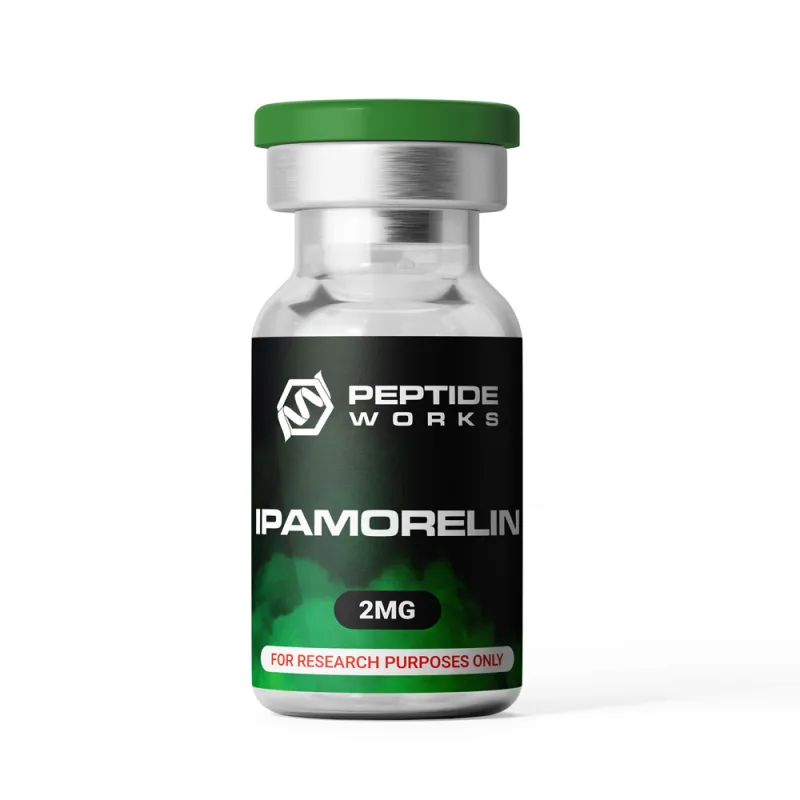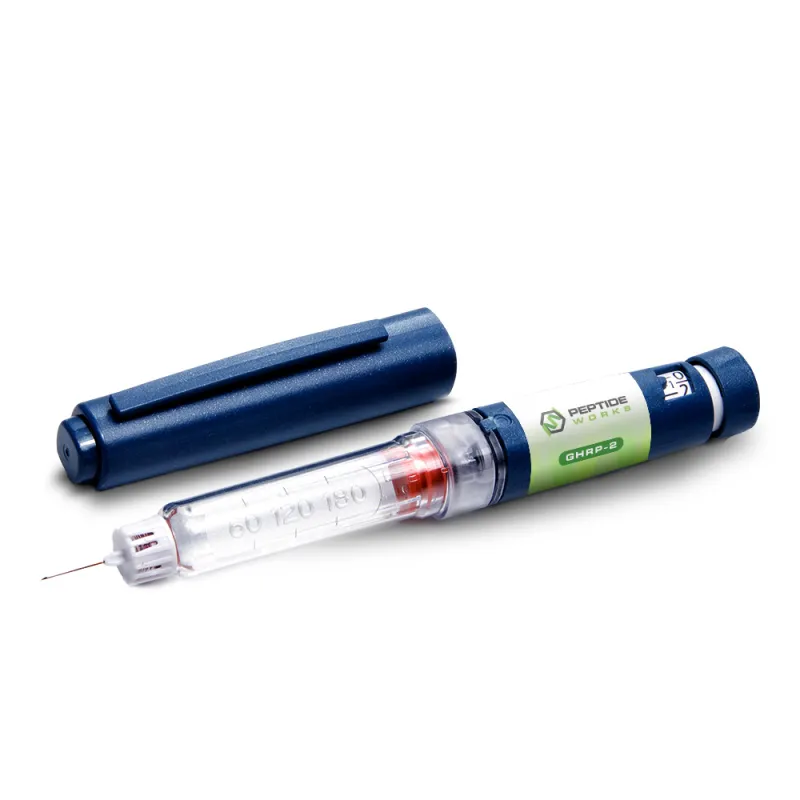
PROMO!
First order? Get 10% OFF with this code: 1storder
Written by

Once people reach their 40s, building lean muscle often feels like an uphill battle. Recovery takes longer, workouts feel tougher, and progress can stall. This is where researchers have started to look at Sermorelin for muscle growth. In studies, Sermorelin acts as a trigger for the pituitary gland, encouraging it to release growth hormone in natural bursts.
That extra push of growth hormone has been linked to better recovery times, improved protein synthesis, and support for lean muscle development. Because of these findings, many discussions in research now highlight Sermorelin’s role in supporting muscle growth as individuals age. The real question is whether the evidence points to a genuine advantage or if the buzz has grown faster than the proof.
To understand this better, it helps to start with the way growth hormone is naturally released in the body.
Discover Sermorelin from Peptide Works, a GHRH analog studied for its ability to trigger natural growth hormone pulses that support muscle research.

One big reason muscle building feels harder after 40 is that growth hormone no longer rises and falls the way it did in younger years. These pulses are important they tell the body to repair muscle fibers, build protein, and recover after tough workouts. Without them, strength gains come slower and recovery feels longer.
That’s why studies on Sermorelin for muscle growth focus so much on this rhythm. Unlike flat hormone levels, pulses keep the body in balance, supporting lean muscle, faster recovery, and more consistent progress over time.
Since these pulses play such a central role, it’s worth looking at the next piece of the puzzle how they connect to IGF-1, a growth factor linked directly to muscle repair.
One of the key reasons researchers study Sermorelin for muscle growth is its effect on IGF-1. When growth hormone pulses reach the liver, IGF-1 is released. This hormone acts as a messenger, telling the body to repair muscle fibers, build new proteins, and fuel recovery after exercise.
Among muscle repair peptides, Sermorelin is notable for its potential to support recovery and promote consistent progress through IGF-1 signaling. IGF-1 is often linked to faster healing, stronger muscles, and better workout results. Higher levels give the body the tools it needs to recover more quickly and keep training progress moving forward, even as natural hormone activity slows with age.
Because Sermorelin is not the only peptide studied for these effects, researchers also compare it with other compounds that influence growth hormone through different pathways. Ipamorelin is one of the most discussed alternatives.

Ipamorelin is often compared with Sermorelin for muscle growth, as both are studied for their effects on growth hormone release, but they work through different pathways. While Sermorelin acts on growth hormone–releasing hormone, Ipamorelin binds to the ghrelin receptor. This action signals the pituitary to release growth hormone in controlled pulses, a pattern linked to muscle repair and recovery.
What sets Ipamorelin apart is its selectivity. Studies suggest it stimulates growth hormone without sharply affecting cortisol or prolactin, hormones that can slow training progress. This makes it a frequent subject in research on lean muscle, fat metabolism, and recovery after exercise.
Another peptide of interest is CJC-1295, which comes in two forms. Both are investigated for their role in muscle growth, but their differences in duration have become a key focus in research.
Explore Ipamorelin from Peptide Works, a selective ghrelin receptor agonist known in studies for stimulating growth hormone with minimal side activity.
CJC-1295 is a growth hormone–releasing hormone analog designed to boost pulsatile GH secretion. The DAC-modified version binds to albumin, giving it a half-life of nearly a week. This extended activity produces sustained elevations in GH and IGF-1, making it a focus in studies on prolonged recovery and anabolic signaling.
The No DAC form lacks the Drug Affinity Complex and is far shorter acting, with effects lasting only a few hours. While less studied, its shorter half-life preserves a release pattern more closely aligned with natural physiology. Researchers often compare the effects of CJC-1295 DAC with those of the No DAC form on muscle growth outcomes.
Alongside CJC-1295, another compound often reviewed is GHRP-2. This peptide takes yet another approach to stimulating growth hormone and offers a different perspective in muscle growth studies.
Check out CJC-1295 DAC from Peptide Works, a long-acting peptide examined for sustaining GH and IGF-1 activity over extended periods.

GHRP-2, also known as Pralmorelin, activates the ghrelin receptor to trigger growth hormone release from the pituitary. Researchers often compare it with Sermorelin for muscle growth, since both increase GH but through different pathways. While Sermorelin acts on the GHRH receptor, GHRP-2 can create faster and sharper rises in growth hormone, making it useful in studies on protein synthesis, recovery, and lean muscle development.
At the same time, GHRP-2 has a broader range of activity. Along with boosting GH, it may also affect appetite and cortisol levels. This combination of strong effect and secondary activity gives it a distinct role in muscle growth research.
Because these peptides all act differently, comparisons are often made to see where Sermorelin stands among them.
Discover GHRP-2 from Peptide Works, a ghrelin receptor agonist studied for producing sharp growth hormone spikes tied to muscle growth pathways.
Researchers often ask how different muscle growth peptides compare in muscle studies. Sermorelin for muscle growth is known for supporting natural growth hormone pulses that help recovery and lean muscle repair. Ipamorelin works through the ghrelin receptor and is valued for its selective action, while CJC-1295 with DAC extends growth hormone activity for days. GHRP-2 creates sharper spikes in GH, but it may also affect appetite and cortisol levels.
Each peptide offers a different strength. Some focus on rhythm, others on duration, and some on potency. The table below shows how they are often described in muscle growth research.
| Peptide | Pathway / Action | Muscle Growth Research Notes |
|---|---|---|
| Sermorelin | GHRH receptor → natural GH pulses | Linked to recovery, IGF-1 release, lean muscle support |
| Ipamorelin | Ghrelin receptor → selective GH release | Recovery and lean mass with low cortisol impact |
| CJC-1295 DAC | GHRH analog + DAC → extended half-life | Sustains GH/IGF-1 for longer recovery and anabolic signaling |
| CJC-1295 No DAC | GHRH analog (shorter activity) | Supports natural hormone rhythm and repair cycles |
| GHRP-2 | Ghrelin receptor agonist → strong GH spike | Potent GH release; may raise appetite and cortisol |
With these comparisons in mind, researchers continue to look at where Sermorelin may fit in the bigger picture of muscle growth studies.
Shop CJC-1295 No DAC from Peptide Works, a shorter-acting GHRH analog researched for promoting hormone release patterns closer to physiology.
Is Sermorelin for muscle growth a breakthrough or just hype? Current studies suggest it can encourage natural growth hormone pulses and stimulate IGF-1 activity. Both are important in muscle growth research. Early findings are promising, but the evidence is still developing. Long-term results remain uncertain. For now, Sermorelin stands as a peptide with potential but one that requires further study.
At Peptide Works, we provide high-quality research peptides to researchers and laboratories worldwide. As interest in peptide science grows, Sermorelin will continue to play a central role in muscle growth research. It gives scientists new insights into growth hormone pathways and recovery mechanisms.
All products discussed are supplied for research purposes only and are not intended for human use.
[1] Sinha DK, Balasubramanian A, Tatem AJ, Rivera-Mirabal J, et al. Beyond the androgen receptor: the role of growth hormone secretagogues in the modern management of body composition in hypogonadal males. Transl Androl Urol. 2020 Mar;9(Suppl 2):S149-S159.
[2] Raun K, Hansen BS, Johansen NL, Thøgersen H, et al. Ipamorelin, the first selective growth hormone secretagogue. Eur J Endocrinol. 1998 Nov;139(5):552-61.
[3] Teichman SL, Neale A, Lawrence B, Gagnon C, et al. Prolonged stimulation of growth hormone (GH) and insulin-like growth factor I secretion by CJC-1295, a long-acting analog of GH-releasing hormone, in healthy adults. J Clin Endocrinol Metab. 2006 Mar;91(3):799-805.
[4] Yamamoto D, Ikeshita N, Matsubara T, Tasaki H, et al. GHRP-2, a GHS-R agonist, directly acts on myocytes to attenuate the dexamethasone-induced expressions of muscle-specific ubiquitin ligases, Atrogin-1 and MuRF1. Life Sci. 2008 Feb 27;82(9-10):460-6.
[5] Walker RF. Sermorelin: a better approach to management of adult-onset growth hormone insufficiency? Clin Interv Aging. 2006;1(4):307-8.
ALL CONTENT AND PRODUCT INFORMATION AVAILABLE ON THIS WEBSITE IS FOR EDUCATIONAL PURPOSES ONLY.
DISCLAIMER: These products are intended solely as a research chemical only. This classification allows for their use only for research development and laboratory studies. The information available on our Peptide Works website: https://peptide-works.com/ is provided for educational purposes only. These products are not for human or animal use or consumption in any manner. Handling of these products should be limited to suitably qualified professionals. They are not to be classified as a drug, food, cosmetic, or medicinal product and must not be mislabelled or used as such.
Peptide Works
Related Articles

How effective could Orexin Addiction Therapy be?
Have you ever wondered why some people find it so hard to stop addictive habits, even when they truly want

Can NAD Therapy Improve Cognitive Performance?
NAD Therapy is gaining attention in research for its possible role in brain health. NAD+ (nicotinamide adenine dinucleotide) is a

Enhancing Energy with NAD+ Supplements
Energy is the driving force behind focus, movement, and recovery. When cells have less energy to work with, the body